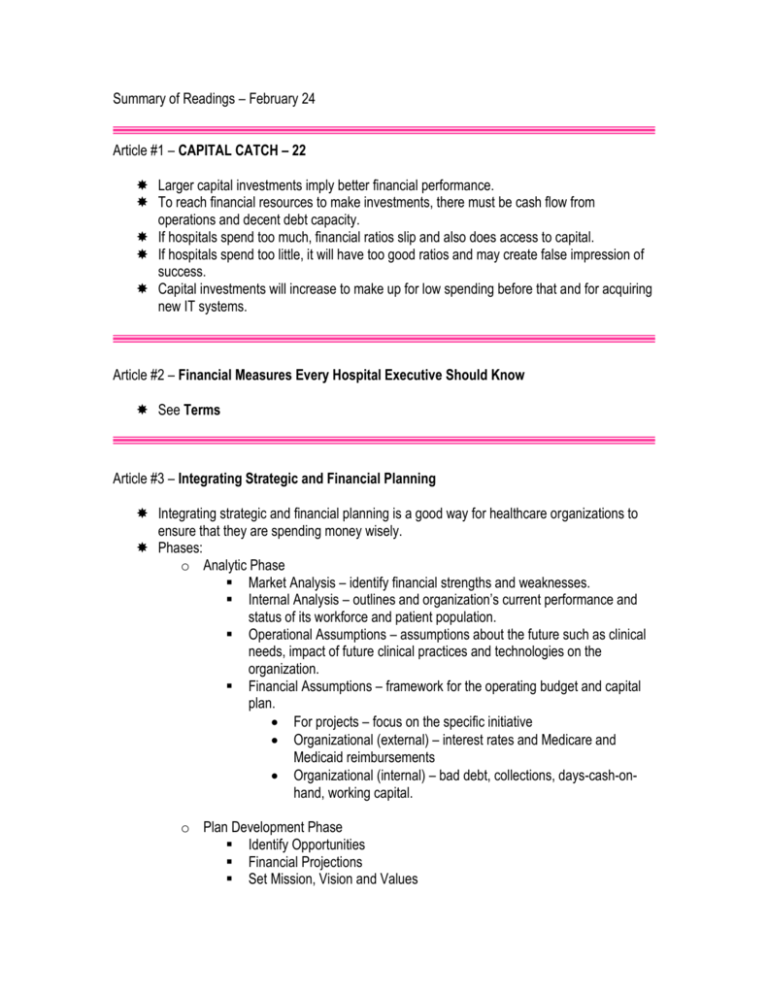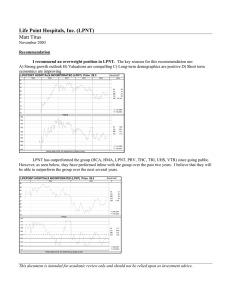Summary of Readings – February 24
advertisement

Summary of Readings – February 24 Article #1 – CAPITAL CATCH – 22 Larger capital investments imply better financial performance. To reach financial resources to make investments, there must be cash flow from operations and decent debt capacity. If hospitals spend too much, financial ratios slip and also does access to capital. If hospitals spend too little, it will have too good ratios and may create false impression of success. Capital investments will increase to make up for low spending before that and for acquiring new IT systems. Article #2 – Financial Measures Every Hospital Executive Should Know See Terms Article #3 – Integrating Strategic and Financial Planning Integrating strategic and financial planning is a good way for healthcare organizations to ensure that they are spending money wisely. Phases: o Analytic Phase Market Analysis – identify financial strengths and weaknesses. Internal Analysis – outlines and organization’s current performance and status of its workforce and patient population. Operational Assumptions – assumptions about the future such as clinical needs, impact of future clinical practices and technologies on the organization. Financial Assumptions – framework for the operating budget and capital plan. For projects – focus on the specific initiative Organizational (external) – interest rates and Medicare and Medicaid reimbursements Organizational (internal) – bad debt, collections, days-cash-onhand, working capital. o Plan Development Phase Identify Opportunities Financial Projections Set Mission, Vision and Values Prioritize Opportunities Develop Operational Plan and Financial Plans o Implementation Phase Implement the consolidated plan Evaluate results Management Dashboard Make Adjustments Back to Implement Adjustments Article #4 – Capital – Beyond the tried and true in the quest for financing This article describes how Ascension Health (a not-for-profit health system) managed to raise cash to pay down its employee pension funds. What they did was changing their debt on pension funds for another debt. They made their existing bondholders senior. Their debt was up to 4.2 billion, but they expected returns of 387 million over 10 years, since they had very good finances and church plan exemption from federal ERISA regulations. Advice to not-for-profit organizations: Make similar transactions and always look at their capital structure and how to take advantage of it. Synthetic Refundings ‘Hot’ Synthetic refunding consists of issuing variable-rate debt and then swapping it to fixedrate. This move flattens the long term yield curve since long term rates have not been pushed up by the Federal Reserve. It’s a risky transaction. Overcoming the Small and Rural Bias Smaller and rural hospitals tend to be victims of size bias. FHA-242 – is a hospital mortgage guarantee program. It is available for construction, financing, refinancing, remodeling or expansion. Hospitals seeking for financing under the FHA-242 program must be designated as critical access hospitals. Then they may be forced to eliminate or change certain services at the request of federal officials, but they gain cost-based payment for Medicare services, and then become eligible for FHA-242 program. The program is very complicated and requires expert consulting assistance. Fact: 50% of US hospitals have < 50 beds. 70% have no more than 80 beds. Attractive Terms An idea for small, rural hospitals that want to increase their debt capacity is to convince their communities to designate a sales tax to supplement hospital revenues. The combination of community and hospital support along with the interest savings of FHA-242 program may be the best route for many. In conclusion, small and rural hospitals should seek outside help. Consolidating for Capital? Smaller and rural hospitals are likely to be heavily involved in any consolidation trend to try to boost their market share and their access to technology. It is hard to be a smaller hospital because they are trying to afford the cost of technology, the cost of compliance and the cost of implementing electronic rercords.s Article #5 – Strategic Planning Improves Capital Decision Making Strategic Facility Planning (SFP) can ensure the financial success of an integrated delivery system (IDS) and can help financial decision making. SFP takes into account long-term strategy, so it provides a basis for evaluating multiple opportunities. Case: “ABC” Health System o Capital requirements were high due to investments in new medical technologies, information systems, and facilities to expand. o They made a group of 30 for SFP. Here are the steps they followed: Clarify goals and shape expectations for the process. Analyze weaknesses opportunities and threats. Develop workload projections for a 5-yr horizon Interviews with their respective managers. Analyze their hospitals and ambulatory care sites in terms of needs, assets and capital plans o Issues found: Uniform Capacity Measurements – using a consistent approach to measuring capacity for all facilities can identify how volume can best be distributed across the system. Highest and Best Use Compared to Needs – They needed to establish information about best potential uses of buildings and sites. Evaluating Building Condition and Investment-Worthiness – they divided their sites in categories based on conditions (worst, poor, moderate, good, and best) Facility Growth and Site Development Opportunities – Existing sites only allowed them growth based on the geometry and zoning regulations. o Actions Taken The sites with the worst condition were the best opportunity area for redevelopment. New facilities would be costly. Determined a $100 million investment for 5 years. Bought a small hospital and converted it in a clinical specialty hospital. Terms: 1. Financial Strength Index – used to gauge an organization’s financial position. 2. Total Margin – sum of the operating margin and non-operating revenue. 3. Hospital Charge Index – Medicare charge per discharge and Medicare charge per outpatient per outpatient claim. Used to compare with other facilities. 4. Market Share – used to calculate the hospital’s share of services compared with services conducted. 5. Hospital Cost Index (Overall) – measure of hospital efficiency. Assumes that Medicare inpatients and outpatients are the same as non-Medicare. 6. Net Patient Revenue per FTE – measures the efficiency of labor relative to revenue. 7. Debt to Total Assets (%) – sum of the hospital’s total borrowing, compared to what it owns. 8. Days Cash on Hand – measures the number of days of average cash expenses that the hospital maintains in cash or marketable securities. An increasing trend is positive. 9. Subordinate Debt – debt whose holders have a claim on the firm’s assets only after senior debtholder’s claims have been satisfied. 10. Serial mode == multi-annual bonds 11. FHA-242 - Mortgage insurance is a policy that protects lenders against losses that result from defaults on home mortgages. FHA loans require mortgage insurance primarily for borrowers making a down payment of less than 20 percent. 12. IDS – integrated delivery system 13. “Capacity” – facility’s potential to efficiently handle specified work volumes. 14. “Highest and best use” – the optimal utilization of the existing inventory of facility assets to meet projected clinical and functional needs. 15. “Need” – relates to specifically to market demand for services.








